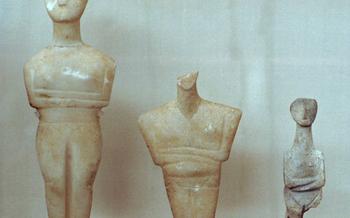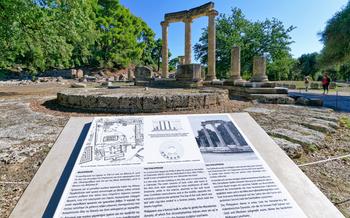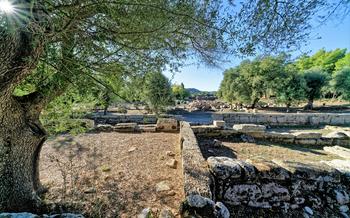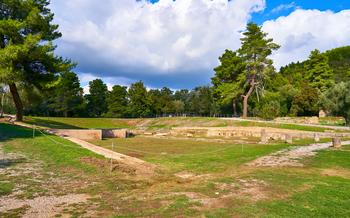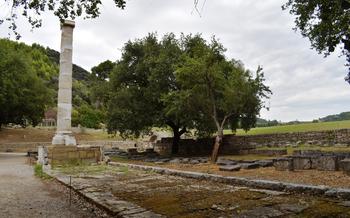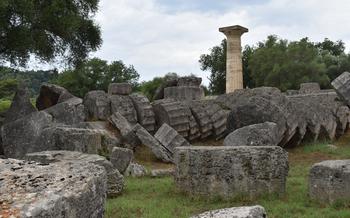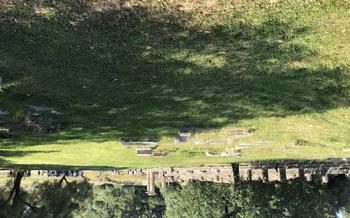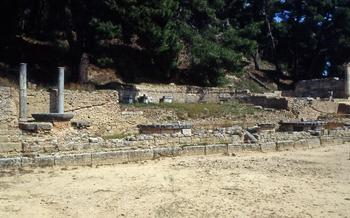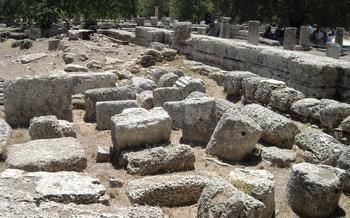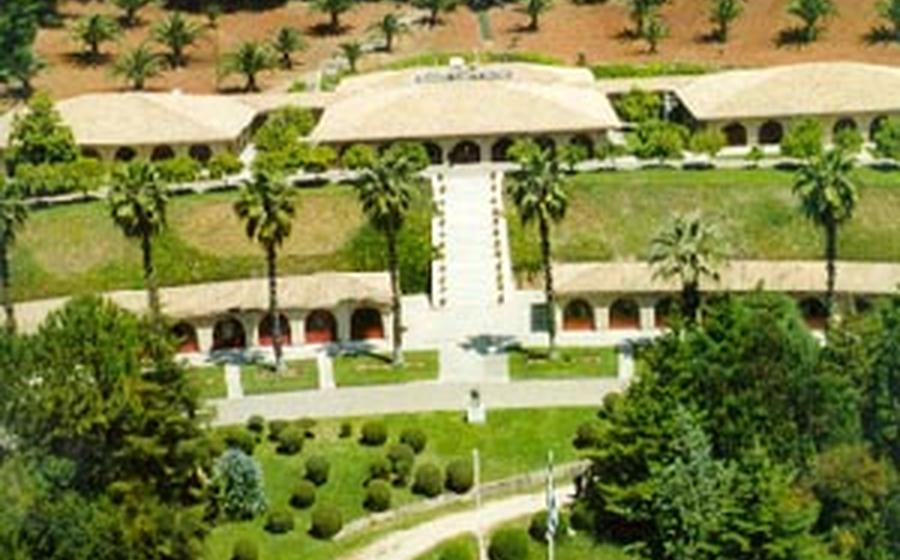
Olympic Academy
- Historical Significance
- Archaeological Treasures
- The Olympic Academy
- Olympic Museum
- Ancient Olympia - The Archaeological Site
- The Sacred Altis
- The Pelopion
- The Bouleuterion:
- The Prytaneion:
- The Gymnasium:
- The Palaestra
- The Stadium
- The Hippodrome:
- The Nymphaeum
- Insider Tip:
Historical Significance
In the heart of ancient Greece, where myths and legends intertwined with reality, the Olympic Games were born. Olympia, a sacred sanctuary dedicated to the gods of Mount Olympus, played a pivotal role in Greek mythology and history. The Games, first held in 776 BC, were a grand spectacle that transcended athletic competition, embodying the ideals of physical excellence, religious devotion, and cultural unity. Athletes from across the Greek world flocked to Olympia to compete in various sports, seeking glory, honor, and the favor of the gods. The Olympic Games were a testament to the Greeks' profound belief in the power of the human body and spirit, reinforcing the bonds of community and fostering a sense of shared identity among the diverse city-states.
Archaeological Treasures
A journey to ancient Olympia brings to light an array of archaeological treasures that evoke the grandeur and splendor of the ancient Olympic Games. The ruins of the Temple of Zeus, once the largest temple in Greece, stand as testament to the artistry and architectural prowess of the ancient Greeks. Intricate sculptures and reliefs adorn the temple's pediments and metopes, depicting tales from Greek mythology and immortalizing the triumphs of Olympian gods.
Among the ruins, discover the Olympic Stadium, where athletes competed for glory and honor. This ancient arena, capable of accommodating up to 45,000 spectators, echoes with the footsteps of legendary athletes who pushed their limits in pursuit of victory. Other sports facilities, such as the palestra and gymnasium, provide a glimpse into the rigorous training regimens undertaken by these ancient athletes, whose dedication and determination continue to inspire modern-day sports enthusiasts.
The Olympic Academy
A modern institution nestled within the ancient grounds of Olympia, the Olympic Academy stands as a beacon of education and cultural exchange. Founded in 1961, its mission is to promote and preserve the Olympic ideals and values, foster international understanding, and contribute to the development of a better and more peaceful world.
The Academy organizes a diverse range of educational programs, conferences, and seminars throughout the year, welcoming scholars, athletes, educators, and enthusiasts from around the globe. These events provide a platform for dialogue, research, and the exchange of ideas on a wide range of topics related to Olympism, sports history, culture, and the enduring legacy of the ancient Games.
Through its academic programs and initiatives, the Olympic Academy strives to promote the spirit of the Olympic Games beyond the realm of sports, emphasizing the importance of fair play, respect for diversity, and the pursuit of excellence in all aspects of life.
Olympic Museum
The Olympic Museum is a must-see attraction for anyone visiting Olympia. It houses a treasure trove of exhibits showcasing the history and legacy of the Olympic Games. Artifacts from past Olympics, such as torches, medals, and uniforms, are displayed alongside interactive displays and multimedia presentations that bring the Games to life. Visitors can learn about the origins of the Games in ancient Greece, the evolution of the modern Olympic movement, and the stories of legendary athletes who have competed in the Olympics. The museum also hosts educational programs and workshops, providing visitors with a deeper understanding of the Olympic spirit and its enduring impact on the world.
Ancient Olympia - The Archaeological Site
Amidst the sun-kissed hills and fertile plains of the Peloponnese lies the ancient city of Olympia, the birthplace of the Olympic Games. Here, where history intertwines with myth, visitors can embark on a journey through time and experience the grandeur of this revered sanctuary.
As you approach the archaeological site, the imposing silhouette of Mount Kronion greets you, its slopes once adorned with sacred groves dedicated to Zeus and other deities. Within the city walls, a treasure trove of ancient ruins awaits exploration, transporting you back to the days when athletes strived for glory and the Olympic flame flickered brightly.
The heart of Ancient Olympia is the Altis, a sacred precinct reserved for religious ceremonies and athletic competitions. Here, you can marvel at the ruins of the Temple of Zeus, once home to the colossal statue of the god crafted by the renowned sculptor Phidias. The temple's majestic columns, intricately carved pediments, and grand scale speak volumes about the devotion and artistry of the ancient Greeks.
Adjacent to the temple lies the Olympic Stadium, where the legendary footraces took place. Imagine the thunderous roar of the crowd as athletes sprinted along the ancient track, their determination etched on their faces. The stadium's simple yet elegant design reflects the emphasis on athleticism and fair play that defined the Olympic spirit from its inception.
As you wander through the site, you'll encounter a myriad of other significant structures, each with its own story to tell. The Bouleuterion, where athletes and officials convened to discuss matters of governance, stands as a testament to the democratic ideals that underpinned the Games. The Prytaneion, where the Olympic flame was tended and offerings were made to the gods, evokes a sense of piety and devotion.
The Gymnasium and Palaestra, where athletes honed their skills and trained for competition, offer a glimpse into the rigorous preparation and dedication required to triumph in the Games. The Hippodrome, where chariot races and equestrian events took place, speaks to the excitement and danger of these ancient sporting spectacles.
Amidst the ruins, the stories of ancient Olympia come alive, inviting you to witness the grandeur of the Games and the spirit of Olympism that continues to inspire athletes and spectators worldwide.
The Sacred Altis
The Sacred Altis, or Altis, was the heart of ancient Olympia and the focal point of religious ceremonies and rituals during the Olympic Games. This sacred precinct was reserved exclusively for the worship of the Greek gods and goddesses and was considered the holiest place in Olympia.
Within the Altis, visitors can explore a remarkable collection of temples, altars, and statues dedicated to various deities. The Temple of Zeus, the largest and most impressive structure in the Altis, once housed a colossal statue of Zeus, crafted from ivory and gold by the renowned sculptor Phidias. The temple's grandeur and intricate decorations symbolized the power and majesty of the king of the gods.
Other notable structures in the Altis include the Temple of Hera, dedicated to the queen of the gods and wife of Zeus; the Pelopion, a sanctuary honoring the mythical hero Pelops; and the Altar of Zeus, where sacred flames were ignited and sacrifices were offered.
The Sacred Altis also played a significant role in the Olympic rituals. The sacred flame, representing the purity and divinity of the Games, was lit here and carried by torchbearers to light the Olympic cauldrons in various cities throughout Greece. This tradition symbolized the spread of the Olympic spirit and the unity of the Greek world.
The Pelopion
A prominent feature within the sacred precinct of Olympia is the Pelopion, a sanctuary dedicated to the mythical hero Pelops. According to Greek mythology, Pelops was a grandson of Zeus and a contender in a chariot race against King Oenomaus of Pisa for the hand of his daughter, Hippodamia. Pelops emerged victorious with the help of the sea god Poseidon, securing his claim to the throne of Pisa.
The Pelopion, situated in the southeastern corner of the Altis, holds historical and mythological significance. Within its confines, the Olympic treasury was once housed, where the city-states of Greece deposited their offerings and financial contributions to the Olympic Games. The treasury was managed by the Eleans, who oversaw the organization and administration of the Games.
In addition to the treasury, the Pelopion was home to several important buildings, including the Pelopion temple, a tholos (circular building), and a heroon (shrine dedicated to a hero). These structures were used for religious ceremonies, rituals, and the commemoration of Pelops and other heroes associated with the Olympic Games.
The Pelopion serves as a testament to the deep-rooted connection between the Olympic Games and Greek mythology. By honoring Pelops, a figure entwined with the origins of the Games, the sanctuary reinforces the sacred and heroic nature of the event that brought together athletes from across the Hellenic world.
The Bouleuterion:
The Bouleuterion, also known as the Council House or Senate Building, was a crucial structure in ancient Olympia. It served as a meeting place for athletes, officials, and representatives of the various city-states participating in the Olympic Games. Here, they would discuss and decide on important matters related to the organization and running of the Games.
The Bouleuterion was a large, rectangular building, constructed in the 5th century BC. It featured an impressive facade with Doric columns and a pediment adorned with intricate sculptures. Inside, the building was divided into a spacious central chamber and smaller side rooms.
The central chamber was used for holding meetings and assemblies. It had tiered seating arranged in a semicircular fashion, allowing participants to face each other and engage in discussions. The side rooms, on the other hand, were used for administrative purposes, such as storing records, preparing documents, and accommodating officials.
The Bouleuterion played a significant role in the political and administrative aspects of the Olympic Games. It was here that decisions were made regarding the eligibility of athletes, the scheduling of events, and the awarding of prizes. The building also served as a venue for resolving disputes and maintaining order during the Games.
Its impressive architectural features and central location within the sanctuary of Olympia underscore the importance of the Bouleuterion in ancient Greek society. It stands as a testament to the organizational prowess and democratic principles that characterized the Olympic Games in antiquity.
The Prytaneion:
The Prytaneion, a significant building within the ancient Olympic complex, served as the official residence for Olympic officials and athletes during the sacred Games. It was a place of hospitality and community, where meals were prepared and religious rituals performed. The Prytaneion was a symbol of the unity and camaraderie that characterized the Olympic spirit.
The building's design reflected its important role. It featured a large central hearth, where the sacred flame of Olympia was kept alight throughout the Games. The hearth was a symbol of the continuity and sanctity of the Olympic tradition. Around the hearth, a series of rooms and chambers provided living quarters for the officials and athletes.
The Prytaneion also functioned as a dining hall, where communal meals were prepared and shared. These meals were an important part of the Olympic experience, fostering a sense of brotherhood and equality among the participants. The food was simple but nutritious, providing the athletes with the energy they needed to perform at their best.
In addition to its practical functions, the Prytaneion held great symbolic significance. It represented the ideals of hospitality and community that were central to the Olympic Games. The building's design and decoration reflected these ideals, creating a space that was both functional and inspiring.
Today, the ruins of the Prytaneion stand as a testament to the enduring legacy of the ancient Olympic Games. Visitors can explore the remains of the building, imagining the bustling activity that once took place within its walls. The Prytaneion is a reminder of the importance of hospitality, community, and the Olympic spirit, values that continue to inspire athletes and spectators alike.
The Gymnasium:
A vital component of the Olympic complex was the Gymnasium, serving as the primary training ground for the athletes. This extensive facility offered a variety of spaces dedicated to physical preparation and conditioning. Wrestlers, runners, and competitors in other disciplines honed their skills within these walls. The Gymnasium's layout and equipment mirrored the significance placed on physical fitness and the pursuit of athletic excellence in ancient Greece. Here, athletes engaged in rigorous training regimens, pushing their limits to achieve peak performance. The Gymnasium stands as a testament to the ancient Greeks' unwavering commitment to physical prowess as an integral aspect of the Olympic Games.
The Palaestra
Adjacent to the gymnasium, the palaestra served as a smaller training area specifically designed for wrestling and boxing. It comprised an open courtyard surrounded by colonnaded porticoes, providing shade and shelter for athletes as they honed their combat skills. The palaestra's compact size allowed for more personalized instruction and supervision by coaches and trainers, who played a crucial role in developing the athletes' techniques and strategies. These dedicated mentors shared their expertise, guiding their charges toward excellence and preparing them for the rigors of competition. The palaestra, with its intense training sessions and focused atmosphere, was a crucible where Olympic hopefuls refined their craft, building both their physical prowess and their mental fortitude.
The Stadium
The heart of ancient Olympia, the Stadium, stands as a testament to the athletic prowess and competitive spirit that defined the Olympic Games. Constructed in the 5th century BC, this awe-inspiring arena hosted the most significant sporting events of the ancient world. Here, athletes from across Greece and beyond showcased their speed, strength, and endurance in a variety of track and field events, including the iconic footraces, wrestling, jumping, and discus and javelin throws.
The Stadium's grandeur is immediately apparent as you step through its ancient entrance. Its elongated rectangular shape, measuring approximately 212 meters in length and 30 meters in width, accommodated up to 45,000 spectators who eagerly watched the unfolding drama. The track itself, made of packed earth, was lined with limestone starting blocks, each representing a different city-state.
As the sun beat down on the Stadium, the air crackled with anticipation. The athletes, stripped to the waist and glistening with oil, took their positions on the starting line. With a herald's trumpet blast, they exploded into motion, their bare feet pounding against the hard ground, their arms and legs pumping in perfect unison. The roar of the crowd reverberated through the Stadium, urging them on to victory.
The Stadium also played host to the thrilling chariot races, a spectacle that combined speed, danger, and excitement. Teams of four horses harnessed to lightweight chariots hurtled around the track, their drivers leaning low to reduce wind resistance and urging their steeds to even greater speeds. The roar of the crowd was deafening, the air thick with dust and the smell of sweat and leather. Crashes were common, and injuries were frequent, but the allure of victory was too strong to resist.
Today, the Stadium stands as a symbol of the enduring legacy of the Olympic Games. Every four years, the Olympic flame is lit here, carried by torchbearers across the globe to the host city of the modern Olympic Games, a tradition that perpetuates the spirit and ideals of the ancient Olympiads.
The Hippodrome:
The ancient hippodrome, located in Olympia, was a magnificent arena dedicated to the thrilling sport of chariot racing. This vast expanse played a pivotal role in the Olympic Games, hosting heart-pounding competitions that showcased the skills and courage of daring charioteers. The hippodrome's elongated track, lined with stone barriers, provided a challenging course for these ancient athletes.
Chariot racing was not merely a display of athleticism; it was a spectacle that captivated the hearts and minds of spectators. The thunderous hooves of horses, the clash of chariots, and the cheers of the crowd created an electrifying atmosphere that left an indelible mark on those who witnessed it. Victories in the hippodrome were highly coveted, and winners were celebrated as heroes, their names forever etched in the annals of Olympic history.
Beyond its sporting significance, the hippodrome held deep cultural and religious meaning. The races were often associated with religious festivals and were seen as a way to honor the gods. The hippodrome served as a sacred space where athletes, spectators, and deities converged in a shared celebration of athletic prowess and divine favor.
In addition to chariot racing, the hippodrome also hosted equestrian events, showcasing the grace and agility of horses and their riders. These displays of horsemanship were met with equal enthusiasm and admiration from the spectators, who marveled at the skill and coordination of the equestrian athletes.
Today, the ruins of the hippodrome stand as a testament to the grandeur of ancient Olympia and the enduring legacy of the Olympic Games. Visitors can explore the site and imagine the excitement and spectacle that unfolded within its walls, feeling a connection to the athletes and spectators who once gathered here to witness the triumphs and tribulations of the ancient sporting world.
The Nymphaeum
A graceful fountain house, known as the Nymphaeum, stands as a testament to the importance of water in ancient Olympia. Dedicated to the nymphs, divine beings associated with fresh water, this structure served a practical and symbolic purpose. It featured a series of basins and channels that collected and purified water from a nearby spring, providing a vital resource for athletes, officials, and visitors alike.
The Nymphaeum's architectural design is a marvel of engineering and aesthetics. Its elegant facade, adorned with intricate carvings and sculptures, reflects the artistic prowess of the ancient Greeks. The rhythmic flow of water cascading through the basins created a soothing ambiance, enhancing the sacred nature of the site.
Beyond its practical function, the Nymphaeum held symbolic significance. The nymphs, revered as guardians of nature and fertility, were closely associated with the Olympic Games. Their presence at Olympia symbolized the harmony between humanity and the natural world, emphasizing the importance of balance and respect for the environment.
As visitors approach the Nymphaeum, they are greeted by a sense of tranquility and serenity. The gentle murmur of water, combined with the intricate carvings depicting mythical creatures and scenes from Greek mythology, creates an immersive experience that transports visitors back in time.
Insider Tip:
-
To fully appreciate the grandeur of Olympia, plan your visit during the shoulder seasons (April-May and September-October) when the weather is pleasant, and the crowds are smaller. This allows you to explore the site at your own pace and truly immerse yourself in its history.
-
Enhance your experience by booking a guided tour with a knowledgeable local guide. They can provide insights into the significance of the various monuments, share fascinating stories, and bring the ancient world to life.
-
For a truly memorable experience, consider staying overnight in Olympia. This gives you ample time to explore the site at a relaxed pace, enjoy the sunset over the Altis, and witness the illumination of the ancient ruins.
-
Indulge in the local cuisine at one of the traditional tavernas in Olympia. Try regional specialties like grilled meats, fresh seafood, and delicious olive oil-based dishes.
-
If you have more time, combine your visit to Olympia with a trip to other nearby attractions such as the picturesque village of Ancient Messini, the stunning beaches of the Peloponnese, or the vibrant city of Kalamata.
